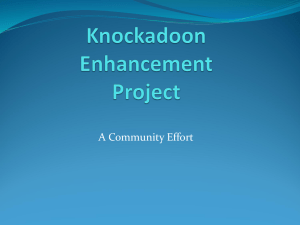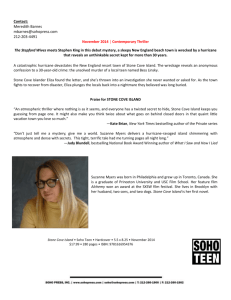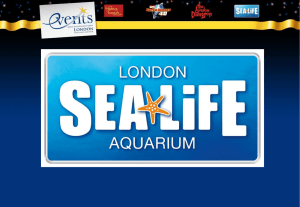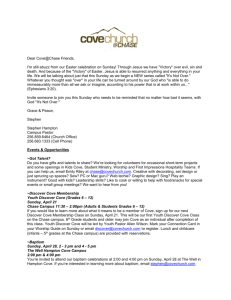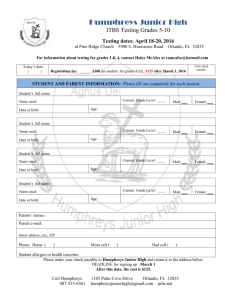Community Consultation DRAFT report nophoto
advertisement
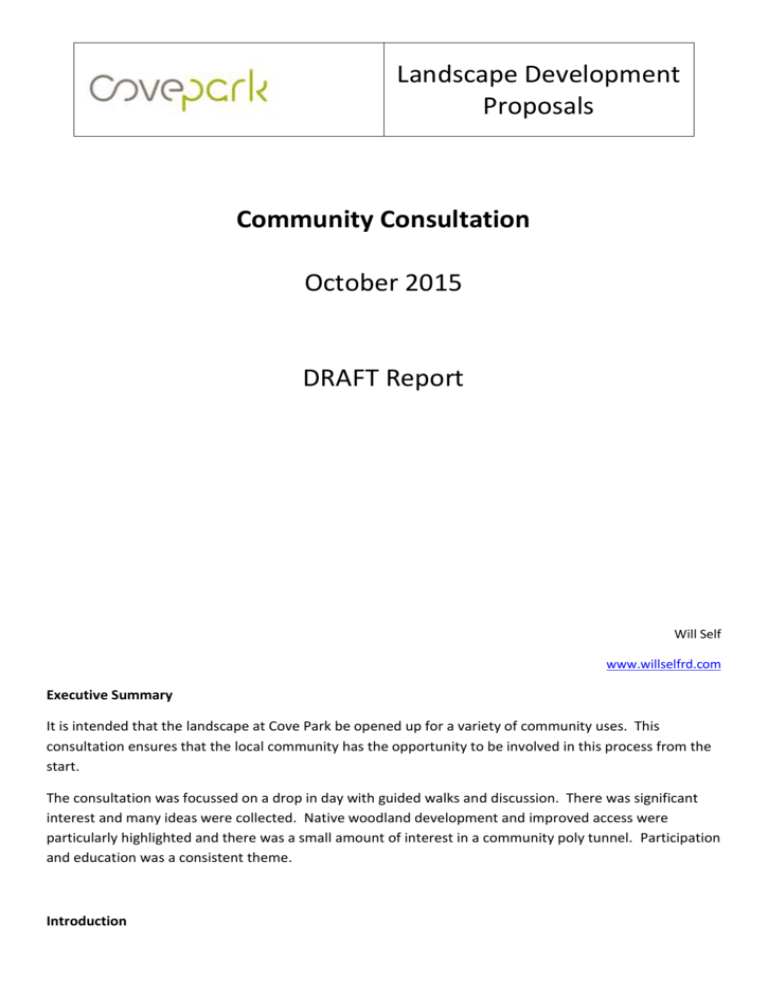
Landscape Development Proposals Community Consultation October 2015 DRAFT Report Will Self www.willselfrd.com Executive Summary It is intended that the landscape at Cove Park be opened up for a variety of community uses. This consultation ensures that the local community has the opportunity to be involved in this process from the start. The consultation was focussed on a drop in day with guided walks and discussion. There was significant interest and many ideas were collected. Native woodland development and improved access were particularly highlighted and there was a small amount of interest in a community poly tunnel. Participation and education was a consistent theme. Introduction Scotland’s International Artist Residency Centre is at Cove Park on the Rosneath Peninsula in Argyll. It is a registered charity and since 2000 has hosted hundreds of artists of all disciplines from all over the world. A new centre is being built which will open in 2016 and the grounds of the 50 acre site will be improved. While there is a requirement to provide resident artists with a sense of space there is a desire from within Cove Park and from the local community to improve the ecology of the land and open it up to more people. This community consultation is the start of a process of engagement of the local people in the landscape at Cove Park. The consultation was funded by the Forestry Commission Scotland Community Seedcorn Fund for small projects under £1000. Consultation Process A drop in day was chosen as the best way to directly engage the community as it is flexible and informal. Importantly, the event on Friday 9th October was very well publicised locally and through Cove Park media outlets. As well as raising awareness of the landscape development this also gave people the opportunity to engage on site on the day and remotely via email and phone. The event had to be carefully coordinated as part of the site, including the main access, was cordoned off for demolition and building works. The event was facilitated by Will Self, a rural development specialist and Gordon Gray-Stephens, a woodland specialist with Cove Park staff. In order to encourage active participation two questions were asked: “What do we want to be able to do?” and “How do we want to get there?” The day was divided into a morning consultation for invited stakeholders and an open afternoon for all. Visitors were guided round the site and points from discussions were recorded. Information was circulated via social media after the event to encourage those that were not able to attend to contribute. In particular input is still being sought from the Rosneath Peninsula schools. Discussions were guided to be wide reaching but relevant. There was enthusiastic involvement throughout the day with some of the morning visitors choosing to stay into the afternoon. The results are recorded below as snapshots of the discussions. Results Awareness A significant result is the raised awareness locally about potential community use of Cove Park through high visibility publicity for the event and the success of the drop in. Event feedback from the public Native woodland development and improved access were particularly highlighted and there was a small amount of interest in a community poly tunnel. The importance of providing education and the process of community participation were also highlighted. The feedback from the consultation is listed below in full to help guide future developments. Comments from participants in the morning: Very important to maintain a sense of place Spread the costs through community participation The landscape at Cove Park is currently degraded by over grazing therefore management is required Link Peaton Hill, Cove Park and the Peace Woods with a trail Have small tracks through the land for getting into the land Cows need to be better managed Important to manage access rather than try to prevent it What are the priorities of Cove Park? There is an ambiguity of privacy for artists and open access A staged approach to landscape management is required at Cove Park People locally feel they don’t have access to Cove Park A feeling of ownership of the site by residents is important Cove Park should be able to manage the land rather than an external grazier Local farmers are important actors Little outside spaces and special outside spaces are needed How do we best manage grass? Strimmers, scythes, grazing? Scythes are better than strimmers in most ways Offer a scythe course The current Scottish Environment Minister has a strong interest in small community environmental projects A Peaton Hill to Cove park path would be good. Could Peaton Hill lead on the development of this? Peaton Hill is owned by the MOD therefore it can be bureaucratic to deal with John Simpson, The MOD police wildlife crime officer and volunteer at Peaton Hill offered support A leaflet should be provided with trail information Decent fences are needed for deer and livestock management Grants are available for woodland management including deer fencing Duchess Woods is used all the time and is highly stimulating for kids Community woodland often leads to many other community benefits e.g. Kilfinan Community Woodland – an early visit to Kilfinan is recommended There is a small poly tunnel at Kilcreggan Primary School There is a model of horticultural partnership with Helensburgh at Ardarden Estate School Eco Flag projects could be undertaken at Cove Park After school, holiday clubs, John Muir and Duke of Edinburgh Awards could use Cove Park Course provision would give a better interaction of locals with the residents It would be fun for children to engage and inspire them with contact with residents Could there be a joint resource issue with Linn Botanic Gardens? Hermitage Park in Helensburgh is very keen to be involved and to be partners in this project There are good skills exchange opportunities with Hermitage Park including a men’s shed project Interpretation potential with Cove Park artists at Hermitage Park Hermitage Park has a good core staff that could be shared including a volunteer co-ordinator Argyll Coast and Countryside Trust is already involved at Hermitage Park Hermitage Park has a resource of a large user group and a large number of volunteers Perhaps focus on gardening specialist plants e.g. dyeing plants and share resources with Hermitage Park Peaton Hill Community Nature Reserve wants to link with a community project locally Peaton Glen Wood Trust has three pieces of land close together for conservation purposes. Access is a lesser priority Could Cove Park offer camping or caravanning in exchange for voluntary work? A recreational poly tunnel with such fantastic views would be unique in the area There is a tourism potential e.g. with NVA and the trail at Cardross Natural regeneration of trees where possible is desirable with planting of native species elsewhere Tree planting has already been undertaken at the top of the site (13 years old with hawthorn) Outside seating should be incorporated People need to drive to Cove Park (not served by public transport) Transport will be an impediment for some community use, particularly schools (coaches cost hundreds of pounds per day) If transport is a barrier then funding should be sourced for it Investigate Council mini-busses for community group use People feel they don’t know what happens at Cove Park There is very high local sensitivity for black grouse and hen harriers to be considered with any developments Residencies could be based around black grouse and hen harriers Set up children’s focus groups at inception Cove Park is 10 minutes drive from the local primary schools Lomond School children ask about an art club There is no local forest school but there is a need for it The major growing time for plants is during the school summer holidays For schools the woodlands should be the main focus and not the gardens or poly tunnel Provide a programme of events for a holiday club This project at Cove Park could be a catalyst for community broadband Exchange between the Helensburgh glass house and a poly tunnel Mix gardeners and non-gardeners and include the woodlands Open up the walking loops currently clogged with gorse A planting plan would need to include an archaeological survey Visibly co-ordinated community groups will be much more attractive to locals, donors and others Future proofing should be built in to proposals e.g. broadband Any community dialogue can lead to unforeseen benefits (It is good to talk) Health and well-being should be a focus for access proposals Grants are available for promoting public access Paths for All provide grants and advice for access Beware of the danger of duplication Build partnerships to share volunteers, training and demonstrations Pool money, people and time and share with other organisations Comments from participants in the afternoon: There should be no artwork on site so that the place is new for each person Have an outside exhibition space for rotating exhibitions not permanent installations An outdoor exhibition space could be on the site of one of the WWII bases What could a poly tunnel be used for as a space? Would curatorial residencies be possible? Possibly leading to local exhibitions? Lomond School has small grounds so is looking for new places Also getting out of the school grounds gives a better focus and it is close enough to the school The Lomond kids could plant trees Children could meet visiting artists Opportunities for John Muir Awards A Lomond forest school, especially for the younger children, could be a good long term project The Lomond School Biology and Geography departments are interested in Cove Park as a venue for field work e.g. the geographers could work with a woodland specialist on soil analysis and tree planting There is opportunity for resident artists to work with locals e.g. with John Simpson on wildlife projects Opening up land beyond livestock will open it up more to people A poly tunnel visit to Kilfinan Community Forest poly tunnel should happen soon Community partners could be valuable to the resident artists for provision of venues Community partners could be valuable to the resident artists as people Explore the wildlife and conservation opportunities For resident artists collaboration could be the key value from grounds / landscape partnerships An artist in residence could be a practitioner in woodland planting There could be architecture or building residencies Walter Segal timber kit building is easy to construct and cheap (architect Duncan Roberts – Northumberland) See Architecture and Design Scotland Timber build provides good insulation There could be funding for apprentices to build units Herbs and salads may be more realistic in a poly tunnel at Cove Park rather than vegetables Poly tunnels are also great places to dry logs Event opportunities will extend the season Keep it interesting and “left field”


